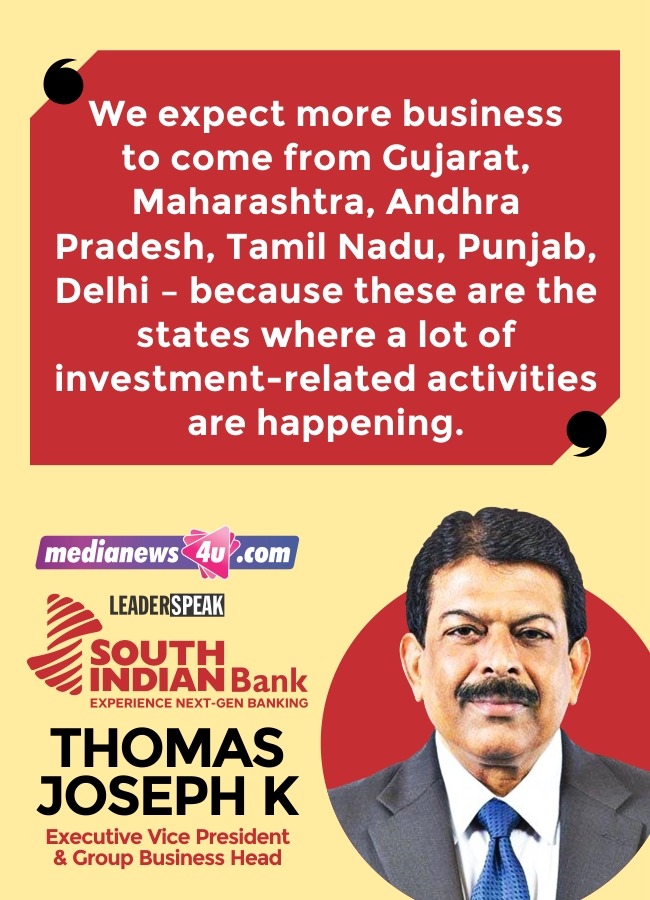In conversation with Medianews4u.com, Thomas Joseph K, Executive Vice President & Group Business Head, South Indian bank spoke about the growth in digital transactions, geographical expansions, and more.
The share of digital transactions went up to 93.3pc in FY 22, up from 89.8 pc the previous year. Can you retrace the rise in digital transactions, especially since FY 2020?
Digital transaction volumes have been growing consistently around 5 to 10 per cent every year. Digital transactions of banks across the country is witnessing consistent growth owing to various initiatives by the government and RBI.
What worked well for South Indian Bank is the revamping of our mobile banking app. We have done total revamping of SIB Mirror+. We want to take the figure to 98pc, which is a very reasonable number because the incremental business is coming through digital. For example: When a new account is being opened, it is done through digital. Around 55 pc of our new account openings is done through digital platforms.
The new customers who get onboarded come with a digital-savvy mindset and knowledge, which makes life simple for bankers. As ours is a legacy 94-year-old brand, lots of customers still use the traditional way of banking like usage of cheque books etc. That base will continue. But, almost all the incremental business will be digital.
We are working on our internet banking system to make it more user friendly. Beyond that we are looking for fintech tie-ups. Two years back onboarding a borrower was done manually, now we are doing it digitally. Corporate (business correspondent) arrangements also happen over digital platforms.
You reportedly spend Rs. 150 to 200 crore on technology. Have spends on (i) technology and (ii) digital marketing also gone up parallel to the shift to digital transactions?
Our priority was to construct a convenient and safe platform for customers. We have been spending a lot of money towards creating infrastructure with enough buffer to take care of the spikes that happen occasionally.
When it comes to fintech tie ups, there is not much cost involved, as the technology cost is borne by the fintech platforms.
Digital transactions mostly happen through fintechs. Except for the integration there is no capex involved.
If you take the incremental spend, more than 50pc is on digital as it is the future. So, infrastructure and digital initiatives is where we spend money.
How have services like online account opening taken off for SIB?
We have a centralised account opening system. When the volumes started increasing, we introduced a ‘Do It Yourself Account’ (DIYA) to make it easy for both customers and staff. The same process followed in the centralised account open system is followed here.
We have video KYC account opening and instant account opening. We are now getting into tie-ups with fintech companies for the same, where we will be using their platforms and they will be sourcing customers to get onboarded to our platform.
94 years, over 70 lakh customers. How are the customers spread geographically? In how many cities are the current 928 branches spread?
SIB has stated plans for opening 10 to 15 branches a year. Which are the cities you are planning to expand in / to?
We are in 30 states and cover 168 districts across the country. In Kerala we are present almost everywhere, be it cities, villages or panchayats. In Tamil Nadu, we are close to that, not necessarily present in all villages, but in the prominent towns. Same is the case with Karnataka, Andhra Pradesh, and Telangana.
At the same time, in AP and Telangana and the rest of India, we are primarily present in the urban areas and not the rural ones. What we are planning is to open more branches in those locations where we don’t have presence in C & D class cities outside South India.
In the 1950s and 60s, we took over a few banks in Kerala due to which we have multiple branches in Kerala which lie very close to each other. We are merging those branches and the licenses of those will be used to expand branches outside South India.
When it comes to North India, we are largely present in Delhi, NCR region, and Punjab. These are all urban. A South-based bank spreading across rural areas in the North would be difficult to manage initially. Now that we have strong footage in the above-mentioned areas, we can look at expanding outside the cities as well.
In the West, in Bombay alone, we have 19 branches. In Maharashtra we have 30 branches, in Gujarat we have around 28 and have a presence in Goa as well. Most of the business advances come from Maharashtra and Mumbai.
We were not bullish about the East. But of late we are finding a lot of traction in the MSME sector there. In the North East also we have a lot of opportunities coming up. We have opened a few branches there which are performing well.
If you ask me where do I expect more business comes from, I would say Gujarat, Maharashtra, Andhra Pradesh, Tamil Nadu, Punjab, Delhi – because these are the states where a lot of investment-related activities are happening. These are the areas we want to expand the business to.

You recently launched an MSME online portal providing instant online ‘in principle’ loan approval up to Rs.1 crore. How big is the MSME space for SIB and which are the major sectors you are planning to cater to with this portal?
MSME contributes 27 pc of our total asset book. It is a very important portfolio for us. If you look at the history of South Indian Bank, we have been growing as a small business-friendly bank. Within MSME, we have more traders than manufacturers. What we are focusing now is to add more manufacturers, that’s one of the objectives behind the online portal.
We are planning to serve the customers where we are not present today. This is a very customer-friendly app. You can enter the credentials and if you are through the process, then the disbursements happen digitally.
Right now, we have launched collateral-based lending. Within a few weeks, we will launch unsecured loans as well.
Overall, what is the share of personal banking and business banking for SIB? Will this remain at this ratio or do you see this shift?
22 pc is personal banking, 27 pc from business, roughly 31 pc comes from corporate business, and 20 pc agri business.
We don’t expect the agri business to grow, but when we are planning for double-digit growth, there will be some growth in that sector as well.
In the corporate banking segment, we have reasonable exposure and depending on the opportunities available we will grow.
Our focus is to grow in the MSME and personal segment. We are planning to introduce value-added or high-income products in the personal loan and MSME segments.

How big are gold loans for SIB? With a deluge of private players coming into play and their aggressive promotion, has the gold loan business of traditional lenders been affected?
South Indian Bank’s total book of gold loans is Rs.13,000 crores. For the last few years, gold has been an important product for the bank. At some point, we were trying to look for capital due to low profitability. We were looking for a low capital asset and the gold loan is a segment where no capital is required. We have been pushing the business for quite some time. Of late the overall customers in the gold loan segment in the country itself has gone up.
There is a share for everyone in the segment and South Indian bank has introduced technology in this segment as well.
The opening up of banks and newer players – do you think that will have an impact on legacy brands? How will SIB as a legacy brand leverage trust in the new age of competition?
I have been in the industry for quite some time and have witnessed the entry of all new generation banks.
At one point, there was a talk that with the entry of new-gen banks, old banks will be affected or have to shutdown. In reality, these banks create a lot of markets for the entire banking industry. Even today, we are in the same growth trajectory as them.
If more banks come, they come with different strengths. They will go to some new areas where we haven’t gone. Hence they will create a market there and we will get a share of that as well.
The advantage of being a legacy brand is that we don’t have to market ourselves. The factor of trust and confidence is already established.

















